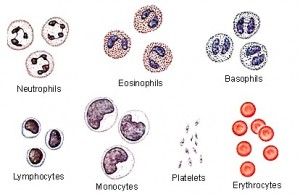White blood cells (WBC) are cells found in the immune system and defend the body from infectious diseases and harmful foreign materials. These cells are found throughout the body and when the normal WBC levels change to either high or low, it may indicate the presence of a disease.
There are different types of white blood cells and they are:
• Neutrophil – is a cell that acts as a defender against fungal or bacterial infections.
• Eosinophils – are cells that usually deal with parasitic infections and are also predominant during allergic reactions.
• Basophils – are cells responsible for our bodies’ response to allergic and antigen reactions by releasing a histamine chemical that causes vasodilation.
• Lymphocytes – are most commonly found in the lymphatic system and they are responsible for the body’s immune system. Lymphocyte is categorized into three different types, namely, B cells, T cells, and natural killer cells. The B cells are cells that form antibodies to attack the bacteria and toxins that infiltrate our bodies. The T cells are cells that attack our own body cells that have become cancerous or taken over by certain viruses. And natural killer cells are cells that naturally react and destroy contaminated cells without prior activation.
• Monocytes – share the same function as neutrophils but the difference is they live much longer.
Complete Blood Count
A complete blood count (CBC) is performed to measure the level of white blood cells in our body. A white blood count is also known as differential count because in a white blood cell there are 5 types that need to be measured, namely, neutrophils, eosinophils, basophils, lymphocytes, and monocytes. Read more about how to interpret Complete Blood Count Test Report
WBC Normal Results
Normal WBC levels are different between men and women but a typical WBC count is from 4,000 to 10,000 cells per millimeter cube. A normal neutrophil level would at least have 50 – 70% of the relative value; eosinophils will have 1 – 3% relative value; basophils will have 0.4% – 1% relative value; lymphocytes will have 25 – 35% relative value; and monocytes have at least 4 – 6% relative value.
WBC Abnormal Results
When normal WBC levels are not achieved, results would either be a high or low WBC.
Low White Blood Cell Count
A decrease in the normal WBC levels would indicate two things, namely, neutropenia and leucopenia. Nuetropenia is when the number of neutrophils decreases which leads to a low white blood count. Neutropenia is a condition in which the body is not able to defend itself from infections. The risk caused by neutropenia depends on its cause and severity.
Meanwhile leukopenia occurs when the normal WBC level drops to below 4,000. It weakens the immune system which put us at higher risk of various infections. Causes of leuokopenia are deficiency in the bone marrow, collagen-vascular diseases, disease in the liver or spleen, and exposure to radiation therapy. People with leukopenia are more prone to get cancer and AIDS when HIV is acquired.
Tips to reduce the risk of infection to people with low WBC counts:
• Frequent washing of hands
• Avoid direct contact with people who are sick
• Avoid any dental works especially when CBC is low
Call a doctor or a health care provider when normal WBC levels are low and accompanied by such conditions:
• A high temperature with more than or equal to 100.5°F
• Chilling or shaking
• Sudden unexplained pain
• Sores in the mouth
• Presence of white coating in the mouth most especially in the tongue
Treatment for low white blood count includes:
• Anti-microbial medications such as sulfamethoxazole, trimethoprim, acycolovir, flucanozole, and intraconazole are used to prevent specific infections from occurring.
• Antibiotics are also given to treat certain infections
• Other medications like Filgrastim, Peg – Filgrastim, and Sargramostim prevent WBC from falling too low for too long.
High White Blood Cell Count
An increase in the normal WBC levels is sometimes called leukocytosis. It is a sign of abnormality in the bone marrow and death or maturation of cells associated with leukemia.
Some of the possible causes of Leukocytosis are as follows:
• Bacterial Infection
• Stress
• Medications
• Death of tissues
• Leukemia
• Pregnancy
• Dermatitis
Increased WBC levels indicate that a serious disease or massive infection is currently happening. In some cases treatment of infection is not necessary for it can resolve on its own, but on severe cases of bone marrow disorder, a bone marrow transplant and chemotherapy is used to treat leukocytosis.
Facts about WBC Counts
• Newborn infants normally have high numbers of white blood cells ranging from 9,000 to 30,000 WBC and this number would fall to normal adult level after 2 weeks from date of birth.
• As we get older, our white blood cell count slightly decreases.
The lifespan of a white blood cell would last from 13 to 20 days and the days after that, they would be destroyed in the lymphatic system. Throughout their lifespan they help and protect our body from harmful infections and diseases. Normal WBC levels goes high or low when a person is under stress. To help avoid abnormalities in the white blood cells it is best to learn to control yourself even under stressful moments.


The subsequent time I read a weblog, I hope that it doesnt disappoint me as much as this one. I mean, I do know it was my option to read, but I actually thought youd have something attention-grabbing to say. All I hear is a bunch of whining about something that you possibly can fix for those who werent too busy on the lookout for attention.